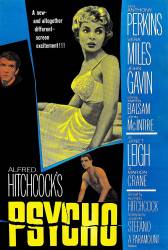Continuity mistake: As the camera zooms into the hotel window, you can see a shadow on the blinds. But in the next shot, the shadow is now longer (even though it's supposed to be in real time). (00:02:30)

Continuity mistake: When the Highway Patrol Officer hands the driver license back to Marion, in the interior shot he's holding it out with his right hand and Marion takes it with her left hand, but in the next exterior shot he's handing it to her with his left hand and Marion is taking it with her right hand. (00:15:50)
Continuity mistake: When Marion gets out of her car at the dealership, she is holding her purse with her hands. But in the next shot, her purse is now around her left arm. (00:17:40)
Audio problem: When Norman runs down from the Bates house to the motel and meets Marion, he says "Gee, I'm sorry I didn't hear you in all this rain. Go ahead in, please." But you look closely, it looks like Norman is barely moving his lips. In fact it looks like Marion is saying something instead. (00:27:50)
Continuity mistake: When Marion steps into the shower and pulls the curtain shut, if you look closely, you can see a rubber bath mat with holes in it. After this shot, the mat is not seen again (during the murder or the clean-up). (00:46:20)
Continuity mistake: When Marion steps into the shower, we can hear (not see) her unwrap a bar of soap and throw the wrapper on the floor of the shower. But when Norman is cleaning the bathtub, after Marion is killed, the wrapper is no where in sight. (00:46:30 - 00:53:00)
Continuity mistake: While in the shower, Marion rubs her right arm with a bar of soap and her hair has yet to get wet. But in the next shot, the soap has disappeared from her hand and most of her hair is wet. (00:46:45)
Visible crew/equipment: While Janet Leigh is being stabbed to death by Mother, as Janet turns around in the shower, it is possible to see part of the moleskin that Janet wore for the scene for a split second. (00:47:30)
Factual error: When Janet Leigh is shown lying dead on the floor of the shower, there is a close-up of her open eye. The pupil is contracted to a pinpoint (obviously due to the bright lighting) where it should have been dilated. After the film was released, Hitchcock heard from several ophthalmologists who pointed this out and suggested he use belladonna eye drops in the eyes of "dead" people in future films, as the chemical prevents the pupils from contracting. (00:48:30)
Continuity mistake: After seeing Marion's dead body in the bathroom, Norman accidentally knocks down a framed picture of a bird (with the picture facing up and it is a few inches away from the wall). But when Norman is spreading the shower curtain on the floor, the picture has changed position (with the picture now facing down and it is against the wall). (00:49:50 - 00:51:45)
Continuity mistake: In the scene after Norman kills Marion, when he goes back into cabin 1 to move her body and clean the bathroom, look on the floor between the bathtub and the toilet and you'll see a pair of bathroom slippers. As he mops the bathtub and then dries off the floor with a towel the slippers magically disappear. (00:52:55 - 00:54:05)
Factual error: The car she trades her car for in at the dealership is a used 1957 car, but when Norman is driving it into the swamp you can see on the license plate that the expiration year is 1956. It couldn't have a tag that expired before its model year. (00:55:25)
Revealing mistake: When Marion is driving her car through the night, she keeps looking at her speedometer. You can clearly see that the gear shift lever is in "park" as she is driving.
Revealing mistake: After Marion has been murdered there is a close-up of her face. If you look down to her neck you can see her pulse.
Deliberate mistake: When Norman picks up Marion's supposedly naked body to carry it to his trunk, a bra is visible through the shower curtain. Gus Van Sant included this goof in his 1998 remake.
Continuity mistake: In the scene after Janet Leigh is killed Norman goes into Cabin one and starts mopping. He puts the mop in front of the bed for a second. Through the mirror you can see the mop fall when he put it down, but when he goes back to get it, the mop is up again.
Continuity mistake: When Marion and Norman are talking after he has brought in some sandwiches, Marion tears the same piece of bread 3 times on different occasions.
Visible crew/equipment: When Marion is packing in her room, the camera is panning back over the bed to show the newspaper with the cash wrapped up in it. As the camera pans back, one can see the camera's shadow on the bed.
Continuity mistake: When Marion wraps the money in the newspaper, the way the newspaper is folded changes between the wide shots and the close-up shot.
Continuity mistake: In the shot in which Norman goes into the bathroom and puts the pail behind the door, the shower curtain rings are spread out. In the very next shot in which he emerges from behind the door, the rings are in tight groups. As he leaves the bathroom, the rings are spread out again.






Chosen answer: Birds are just a favourite choice of spooky animal that Alfred Hitchcock seems to use hence the film "The Birds". Eyes show the window to our soul where our deepest fears originate and who isn't scared of getting knifed in the shower. The mirrors i can't explain but I can suggest that it just looks creepy.